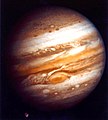File:Jupiter gany.jpg

Dimensioni di questa anteprima: 538 × 600 pixel. Altre risoluzioni: 215 × 240 pixel | 431 × 480 pixel | 673 × 750 pixel.
File originale (673 × 750 pixel, dimensione del file: 114 KB, tipo MIME: image/jpeg)
Cronologia del file
Fare clic su un gruppo data/ora per vedere il file come si presentava nel momento indicato.
| Data/Ora | Miniatura | Dimensioni | Utente | Commento | |
|---|---|---|---|---|---|
| attuale | 12:17, 15 ott 2023 |  | 673 × 750 (114 KB) | 0x0a | offcial JPG, more details |
| 10:19, 16 feb 2016 |  | 970 × 1 081 (281 KB) | PlanetUser | black bg | |
| 06:20, 15 mar 2015 |  | 970 × 1 081 (72 KB) | Jcpag2012 | larger (with auto correction) from TIFF file | |
| 07:24, 22 feb 2015 |  | 758 × 858 (238 KB) | Jcpag2012 | processing | |
| 06:14, 9 nov 2004 |  | 758 × 858 (58 KB) | Gentgeen | {{PD-USGov-NASA}} |
Pagine che usano questo file
La seguente pagina usa questo file:
Utilizzo globale del file
Anche i seguenti wiki usano questo file:
- Usato nelle seguenti pagine di af.wikipedia.org:
- Usato nelle seguenti pagine di ar.wikipedia.org:
- Usato nelle seguenti pagine di be.wikipedia.org:
- Usato nelle seguenti pagine di bg.wikipedia.org:
- Usato nelle seguenti pagine di cs.wikipedia.org:
- Usato nelle seguenti pagine di en.wikipedia.org:
- Usato nelle seguenti pagine di en.wiktionary.org:
- Usato nelle seguenti pagine di es.wikipedia.org:
- Usato nelle seguenti pagine di et.wikipedia.org:
- Usato nelle seguenti pagine di eu.wikipedia.org:
- Usato nelle seguenti pagine di fr.wikipedia.org:
- Usato nelle seguenti pagine di gu.wikipedia.org:
- Usato nelle seguenti pagine di he.wikipedia.org:
- Usato nelle seguenti pagine di hi.wikipedia.org:
- Usato nelle seguenti pagine di hr.wikipedia.org:
- Usato nelle seguenti pagine di hr.wiktionary.org:
- Usato nelle seguenti pagine di hy.wikipedia.org:
- Usato nelle seguenti pagine di id.wikipedia.org:
- Usato nelle seguenti pagine di it.wiktionary.org:
- Usato nelle seguenti pagine di ja.wikipedia.org:
- Usato nelle seguenti pagine di ja.wiktionary.org:
- Usato nelle seguenti pagine di kbp.wikipedia.org:
- Usato nelle seguenti pagine di la.wikipedia.org:
- Usato nelle seguenti pagine di mdf.wikipedia.org:
- Usato nelle seguenti pagine di mk.wikipedia.org:
- Usato nelle seguenti pagine di ml.wikipedia.org:
- Usato nelle seguenti pagine di mr.wikipedia.org:
- Usato nelle seguenti pagine di mwl.wikipedia.org:
- Usato nelle seguenti pagine di nl.wikipedia.org:
- Usato nelle seguenti pagine di no.wikipedia.org:
- Usato nelle seguenti pagine di pl.wikiquote.org:
- Usato nelle seguenti pagine di ps.wikipedia.org:
- Usato nelle seguenti pagine di pt.wikipedia.org:
Visualizza l'utilizzo globale di questo file.



